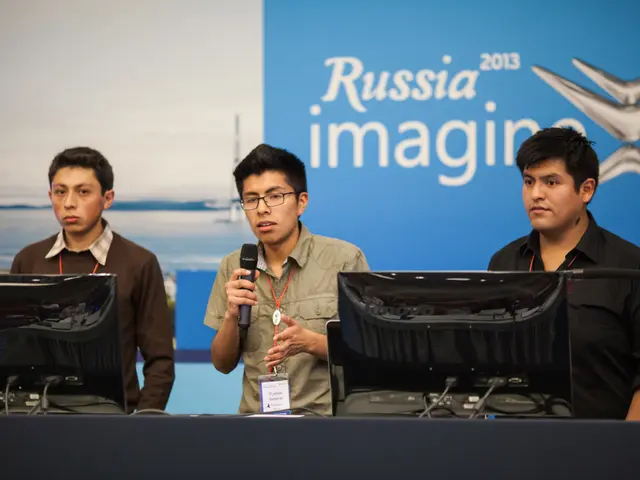Escalating Conflict: Trade War Continues Unabated
Trade Truce Between U.S. and China Offers Temporary Relief, Not Long-Term Solution
Amidst surging stock markets and a quiet commercial front, the recent trade agreement between Washington and Beijing is far from a decisive victory for either nation or a return to lasting peace. Instead, the pact serves as a short-term truce in a larger conflict that continues to inflict economic damage.
Just weeks after President Donald Trump's return to the White House, he set the global economy on a chaotic course with sudden tariff announcements, postponements, and reinstatements. The trade saga climaxed in April with the announcement of additional "reciprocal tariffs" ranging from 11% to 49% on goods exported from nearly 85 countries.
Following a week of financial market turmoil, Trump declared a 90-day truce and reduced the latest round of tariffs to 10% for all except China, with which the U.S. had engaged in an escalation that raised general tariffs to 145% on American exports and 125% on Chinese exports, effectively amounting to an embargo.
Following a ten-day negotiation period, Washington and Beijing agreed to offer each other a three-month reprieve to discuss their differences more calmly and temporarily reduce their existing tariffs to an average effective rate of only 39% and 27%, respectively, according to Goldman Sachs.
Trump hailed the agreement as a significant victory, boasting of having forced a "complete reset" of the commercial relationship. Still, China responded by claiming the upper hand, having forced the Americans to back down.
However, experts at the Financial Times speculate that both sides chose to lower their tariffs due to economic necessity more than political triumph. China is said to have recognized its prolonged dependence on the American market, and Trump reportedly feared market reaction, the threat of inflation, and the prospect of empty store shelves during the holiday season.
Despite the latest concessions, the average effective rate of American tariffs now stands at 17.8%, its highest level in over 90 years according to experts from the Yale University Budget Lab. This rate is projected to cause a long-term loss of 0.4% of U.S. wealth, 0.3% in China, and 2.3% in Canada, with inflation increases and food, vehicle, and clothing prices rising accordingly.
Moreover, the temporary nature of the truce casts doubts on the sustainability of the agreement. The "reciprocal tariffs," which were only placed on hold for 90 days, are set to resume on July 8 for China and in August for other countries. Additionally, Trump has promised sectoral tariffs on pharmaceuticals and lumber.
Anxious nations are lining up outside the White House in hopes of securing a deal before the truce expires. Reports suggest that the Trump administration is focusing on more than 20 economies, including the European Union, Japan, India, South Korea, Vietnam, Argentina, and Israel. Less significant countries may be covered by regional agreements, such as those encompassing all of Africa or Central America.
Negotiating real trade deals requires time and cannot be accomplished in just a few weeks or months, especially with numerous countries simultaneously. The high tariff rate and the uncertainty it breeds continue to weigh on the global economy, as reported by Nobel laureate economist and international trade expert Paul Krugman. "The trade war is far from over," he reminded his subscribers on the digital platform Substack.
As for China, it remains crucial due to the sensitivity of nations regarding potential U.S. trade disputes and the challenges associated with signing a comprehensive agreement with Washington before the truce's end. Instead, China is expected to maintain its current approaches, such as offering hollow promises to increase U.S. goods imports and combatting fentanyl trafficking.
This trajectory suggests that the global economy will continue to grapple with the long-term effects of the United States' significantly increased tariffs and the prevailing climate of uncertainty perpetuated by Trump.
- The recent trade truce between the U.S. and China offers temporary relief, but it is not a long-term solution to the ongoing economic conflict.
- Experts suggest both nations have lowered their tariffs due to economic necessity rather than political triumph, with China recognizing its dependence on the American market and President Trump fearing market reaction and inflation.
- The temporary nature of the truce casts doubts on the sustainability of the agreement, as the "reciprocal tariffs" are set to resume for China and other countries in the coming months.
- Countries around the world are seeking to secure trade deals with the U.S. before the truce expires, with the Trump administration focusing on more than 20 economies including Europe, Japan, India, and China.
- The high tariff rate and the uncertainty it breeds continue to weigh on the global economy, as reported by Nobel laureate economist Paul Krugman. He reminds his subscribers that "the trade war is far from over."







